Why has one knife attacker been labelled a terrorist, and the other, not?
From Sydney’s affluent east to its multicultural west, the city has been dealt a psychological blow. It will take weeks, if not months, for it to recover.
By Deborah Snow
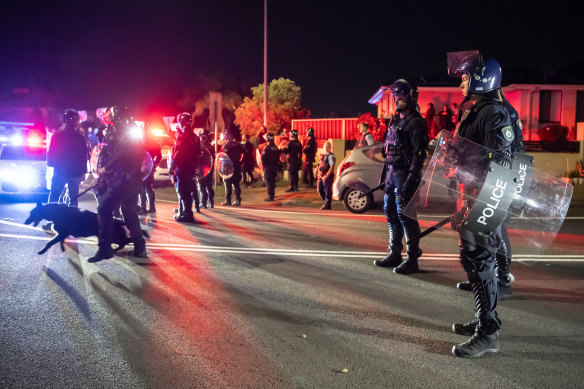
A heavy police presence at the scene of the stabbing at the church in Wakeley, western Sydney.Credit: Wolter Peeters
On Monday night, NSW Multiculturalism Minister Steve Kamper was at home with his wife Magda preparing a meal for their friend, Premier Chris Minns, who’d been through a torrid 48 hours after the horrific stabbings at Westfield Bondi Junction last Saturday afternoon.
Minns had flown to Tokyo to begin a family holiday but he never got to leave the airport before rushing home in the wake of the attack.
Kamper’s plan was to offer his friend some brief respite, with a well-prepared steak and salad. But the plan was upended about 7.45pm, when they received shocking video of a second knife attack, this time on a bishop of an Assyrian Christian church in western Sydney, from the state MP for Fairfield, David Saliba.
It was fortuitous, Kamper said later, that he and Minns were together. Swiftly, with the help of Multicultural NSW CEO Joseph La Posta, the pair set up a late-night Teams meeting with 11 faith leaders across western Sydney. A joint statement was agreed that went out shortly after midnight.
Sixteen Islamic organisations followed suit, condemning what they called the “heinous” attack on the stricken cleric, Mar Mari Emmanuel, a deeply conservative and outspoken preacher who has a massive online following and an outsized profile among Sydney’s Assyrian Christian community.
“We had the concerns, with many others, that this could have escalated dramatically if we didn’t have the right voices and the responsible people within the faith communities making those statements,” Kamper says.
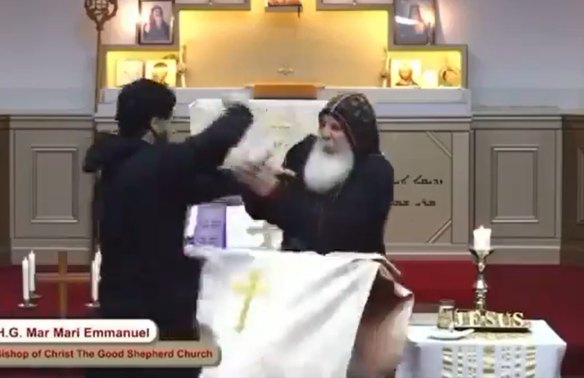
A teenager was arrested after Bishop Mar Mari Emmanuel and Father Isaac Royel were stabbed at Christ The Good Shepherd Church in Wakeley on Monday night.Credit: X/@AustralianJA
“I don’t think I truly appreciated how valuable our interfaith work has been until [Monday] night, when I saw them all get together and stand behind each other, making clear, precise statements and sending important messages to their followers.”
Even as the group’s statement was being drafted, police were struggling to contain a riot that had erupted outside the bishop’s church, the Christ the Good Shepherd Church in Wakeley, in Sydney’s south-west (ironically on Welcome Street).
Emmanuel had been in the middle of a live-streamed sermon when a 16-year-old boy walked casually towards him before pulling out a knife and raining blows on the cleric’s head.
An outraged mob swiftly gathered outside the church, arming themselves with makeshift projectiles and chanting “bring him out” as terrified paramedics sheltered inside. The ensuing battle left 50 officers injured and scores of police vehicles damaged.
A week that began with a mass slaying segued two days later into a live-streamed alleged terror attack and then exploded into a terrifying riot on the streets of a normally quiet suburban enclave, leaving the city plunged into deep shock.
As Minns acknowledged on Thursday morning, after a subdued visit to the Bondi Junction shopping centre where six people had been murdered and a dozen more injured on Saturday, there will be no instant snap-back to normal. From its affluent east to its multicultural west, the city has been dealt a psychological blow, and it will take weeks, if not months, for it to recover.
Yet, the repeated calls for calm and co-operation issued through the week by political and religious leaders seem to have settled some of the apprehension and anguish, at least for now.
The reprisals that were feared against mosques and Islamic prayer halls after Monday night’s knife attack have not eventuated.
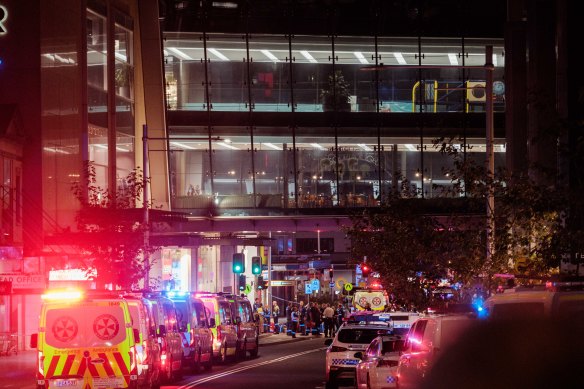
The streets of Bondi Junction in lockdown following the attack.Credit: Oscar Colman
“Everyone has so far breathed a sigh of relief, considering what could have been,” says Australian Federation of Islamic Councils CEO Kamalle Dabboussy. “There were concerns this may have tested our resilience and [led to] further marginalisation of the Muslim community. I believe that the concerns have eased.”
Nevertheless, police have deployed extra resources to guard mosques and places of worship over the weekend, attempting to counter continuing rumours of payback that have been travelling like poison through channels such as Whatsapp.
NSW Police Commissioner Karen Webb, who has put in a sterling performance over recent days, was at pains on Friday morning to assure Sydney’s faith communities they were safe, urging them not to be swayed by false alarms on social media. “If we have current credible information, we will share it with you,” she said. “Police will be the source of truth.”
Lebanese Muslim Association secretary Gamel Kheir, told the Herald his association had advised female staff to work from home on Friday, traditionally a day for prayer among Muslims. “There were rumours circulating that women wearing hijabs [Islamic head coverings] could be singled out for attack,” he says. “Women are an easy target because of their head coverings. We are advising them to walk in groups.”
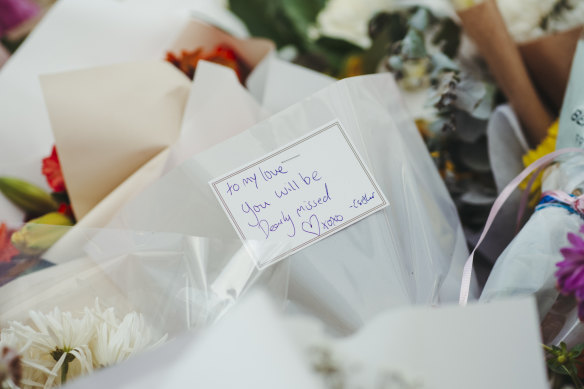
A floral tribute at Bondi.Credit: Dion Georgopoulos
That a measure of calm has descended is due, in no small part, to the rapid mobilisation of a broad coalition of religious and community leaders in the wake of Monday’s attack. There have been several more interfaith meetings through the week, (including one on Thursday that managed the rare feat of bringing together the country’s two Grand Muftis, Dr Ibrahim Abu Mohamed from the Australian National Imams Council and AFIC’s Sheikh Riad El-Rifai.)
By Thursday morning, the injured bishop had recovered enough to directly address his followers from his hospital bed, imploring them to pray, to co-operate with the city’s “beloved” police, and to resist any urge for revenge. “The Lord Jesus never taught us to fight. He never said to us an eye for an eye and a tooth for a tooth,” Emmanuel told his followers.
There remains disquiet among Islamic community leaders about the speed with which police declared the assault on Emmanuel a terrorist incident, given the young age of the attacker.
They say he is a minor, a school dropout whose escalating behavioural and anger management problems have necessitated a referral to psychologists, according to his family.
‘Everyone has so far breathed a sigh of relief, considering what could have been.’
Australian Federation of Islamic Councils CEO Kamalle Dabboussy
Imams council spokesman Bilal Rauf told the Herald there was disappointment that there was a rush to designate it a religious terrorist event before the youth had been spoken to by police noting what he called the “disparity” with Bondi.
Kheir says: “We’ve got to put it into perspective. The act was heinous but having said that, it’s a 16-year-old boy; when you see those photos [of the aftermath] he is smiling; that’s not a natural reaction.”
Community leaders are worried the rushed declaration feeds into negative perceptions of Islam.
But Minns and Webb say the swift declarations of Monday’s crime as terrorism, and an equally swift declaration that Saturday’s was not, were tied to the necessity of unlocking extra investigative powers. It was not signalling how the two attacks ranked in a hierarchy of horror.
Bondi Junction attacker Joel Cauchi was a 40-year-old drifter from Queensland, a “tormented soul” who’d struggled with mental health issues since being diagnosed with schizophrenia as a teenager, according to his father Andrew.
Unsuccessful in forming relationships, he was seemingly in the grip of psychosis when he slaughtered six people He appeared to target women, who made up five of the six dead.
However, police say there was no evidence he was acting from any ideological, religious or political motive, though they say they may never discover what triggered the attack.
Monday’s perpetrator told the parishioners pinning him to the floor immediately after the attack that he had targeted the bishop for disrespect towards “my prophet”. The youth made comments “centred around religion”, Webb would later say.
By the early hours of Tuesday morning, the NSW Police counterterrorism command had advised Webb that the attack on Emmanuel met the “threshold criteria” for declaration as a terrorist incident. Webb made the formal declaration at 1.35am, advising NSW Police Minister Yasmin Catley, who advised Minns at 2am.
A few hours later, Prime Minister Anthony Albanese convened a meeting of the national security committee of cabinet. He fronted a media conference flanked by Australian Federal Police commissioner Reece Kershaw and Australian Security Intelligence Organisation chief Mike Burgess.
As protocol demands following the declaration of a terrorist incident, the matter was immediately referred to the joint counter-terrorism taskforce, which enhances the ability of the security and intelligence agencies to pool their investigative resources.
The declaration also gave NSW Police extra powers of search, interrogation and detention under the state’s Terrorism (Police Powers) Act.
The attacker was charged with a terrorism offence under Commonwealth law on Thursday. On Friday, Parramatta Children’s Court held a bedside hearing at an undisclosed medical facility where he was being held. He had, Webb told a media conference, travelled 90 minutes to reach the church and carry out the attack.
It is the first formally declared terrorist attack in Sydney since an incident at Minto 2016, when 22-year-old Ihsas Khan, an avowed Islamic State sympathiser, stabbed a neighbour in a bid to become a “martyr” protesting Western military intervention in Iraq.
Two other terrorism cases around the same time also featured young men, who, like Monday’s attacker, were in their mid-teens
In April 2017, a 15- and a 16-year-old went on a crime spree in Queanbeyan, slaughtering a Pakistani national who was an attendant at a service station. The letters IS (for Islamic State) were found written in the victim’s blood on the walls. The 16-year-old, who had been diagnosed with schizophrenia a year before, appeared to have been radicalised in the weeks leading up to the attack.
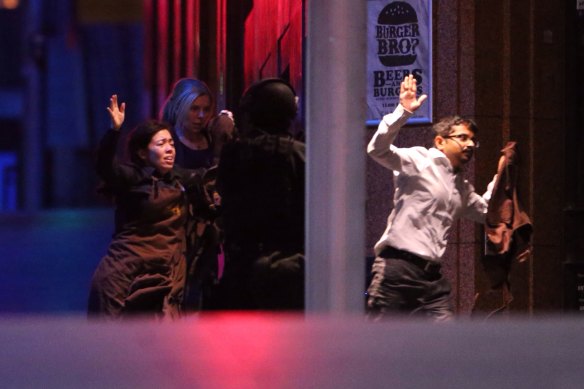
Hostages are assisted from the Lindt Chocolat Cafe in Martin Place in December 2014.Credit: Andrew Meares
In 2015, Sydney police accountant Curtis Cheng was shot in the back of the head by a 15-year-old as he was leaving work at NSW Police headquarters in Parramatta. Several men planned and aided the radicalised youth, Farhad Jabar, to carry out the attack.
Mental health elements were raised in both cases, though as international security consultant Neil Fergus says, the line between a terrorist action and the actions of a psychologically disturbed individual is not always a clean one. (This was also a debate had in the wake of the 2014 Lindt cafe siege carried out by gunman Man Haron Monis).
“There are a number of people carrying out jihadist or other types of terrorist attacks [who] are mentally unbalanced, but [extremist] groups deliberately groom those types of people, too,” Fergus says.
One of the big questions thrown into relief by horrific events of the past week has been how to rein in social media provocateurs, who have been gleefully fanning the flames of discord in the wake of the attacks.
Minns has been particularly scathing about the failure of social media behemoths like Meta and X to swiftly remove graphic messages and vision of the attacks, which was still easily accessible for days afterwards.
The “blithe indifference from social media companies as to the images that are on their platforms” was “shocking”, Minns said.
The federal government has also bought into the issue. Federal Communications Minister Michelle Rowland has pointed to the government’s determination to bring in legislation by the end of the year aimed at forcing social media giants to be more proactive in combating misinformation and disinformation. eSafety Commissioner Julie Inman Grant has issued several ultimatums this week to push the social media giants to take graphic content down.
Mental health resourcing has also come under the spotlight. Minns himself questioned whether the $2.6 billion that the state spends on mental health is being put to its best use.
Police are asking for tougher penalties for knife crime, including sanctions against parents who allow their children to carry a blade.
And there are revived discussions about how to provide a better safety net for disaffected Islamic youth who may have disconnected from their schools, mosques or family networks, and who then become prime candidates for online radicalisation.
Kheir says he doesn’t like the word “deradicalisation” but prefers the term “reintegration”. He and others have been talking to state and federal ministers about the need for what he calls safe youth “hubs”, where such young people might be folded into supportive networks.
“We want to get these kids to integrate successfully into Australian society and culture and the only way you can do that is by keeping tabs on who they are seeing, who they are listening to, who they are being persuaded by,” says Kheir. “The want and need are there, what we are lacking is the financial support.
“We worry about the rogue element, someone who is high on testosterone who thinks he is going to be another martyr for the cause.”
Dabboussy agrees there is “very clearly a need for better youth engagement on both theological as well as diversionary activities”.
The immediate challenge is to convince the Islamic community that police were right to make the call they did early on Tuesday morning.
On Friday, Kershaw said investigative teams were working with “laser-like precision” to find the drivers behind the attack. Webb told reporters “investigators are satisfied that the evidence available has substantiated the charge”.
If you or anyone you know needs help, call Lifeline on 13 11 14 (and see lifeline.org.au) or Beyond Blue on 1300 22 4636 (and see beyondblue.org.au).
The Morning Edition newsletter is our guide to the day’s most important and interesting stories, analysis and insights. Sign up here.